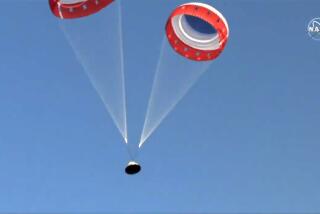Space plane and its secret payload set for launch
An experimental robotic space plane developed for the Air Force is slated to launch Friday from Cape Canaveral, fueling an ongoing mystery about its hush-hush payload and overall mission.
Watching the pilotless spacecraft along with the Pentagon will also be wary Russian and Chinese military officials who have raised questions about U.S. intentions since the government launched its first version of the secret plane into orbit almost a year ago.
The X-37B Orbital Test Vehicle looks like a miniature version of the space shuttle. Because of its clandestine nature, some industry analysts have theorized it could be a precursor to an orbiting weapon, capable of dropping bombs or disabling foreign satellites as it circles the globe.
“It’s a mystery, because the Air Force is being so closed-mouthed about the program,” said Brian Weeden, a former Air Force officer and expert in space security. “It leads people to say, ‘What exactly are they hiding?’”
Air Force officials have offered few details beyond saying the experimental space plane provides a way to test new technologies in outer space, such as satellite sensors and other components.
“It’s a classified mission,” said Maj. Tracy A. Bunko, an Air Force spokeswoman. The spacecraft will be carrying “reusable technologies for America’s future in space and operating experiments, which can then be returned to and examined on Earth.”
The first X-37B was launched from the Cape last April, and 224 days later it landed on its own — fully automated — on a 15,000-foot-long airstrip at Vandenberg Air Force Base, northwest of Santa Barbara. The plane being launched this week is also expected to land there sometime late this year.
The space plane was built in tight secrecy by Boeing Co.’s Space and Intelligence Systems unit in Huntington Beach. Engineering work was done at the company’s facilities in Huntington Beach and Seal Beach. Other components were kicked in from its satellite-making plant in El Segundo.
In recent weeks, the scheduled blast-off has drawn new attention. Lt. Gen. Oleg Ostapenko, the commander of Russia’s space forces, told the state-run Novosti news agency that the military was following the development of the space plane. He said Russian scientists were developing similar technology.
Li Daguang, a professor at People’s Liberation Army National Defense University in China, wrote in an editorial that the technology “will soon have a revolutionary impact on space exploration.” Li went on to write that if the X-37B is used for military purposes, “it is capable of taking military actions against the enemy’s satellite and space transportation devices.”
Most U.S. military analysts are increasingly skeptical that the plane — in its current form — is a space bomber or satellite hunter.
“That’s highly unlikely,” said Weeden, the former Air Force officer who now works at the Secure World Foundation, a Colorado-based space policy group. “At this point, it is an experimental plane. The technology may develop into something bigger — that’s the nature of experimental planes — but it’s just a test bed now.”
Although the X-37B program is “classified,” some of the particulars are known. More than 10 years ago, it began as a NASA program to test new technologies for the space shuttle. But when the government decided to retire the aging fleet of shuttles, the Pentagon took over the program and cloaked it in secrecy.
The spacecraft is about 29 feet long, or about the size of a small school bus, with stubby wings that stretch out about 15 feet tip to tip. It is one-fifth the size of the space shuttle and can draw on the sun for electricity using unfolding solar panels. It is designed to stay in orbit for 270 days.
Weather permitting, the plane is set to be launched Friday atop a 19-story Atlas V rocket, which will lift the spacecraft into orbit inside the nose cone. Once in orbit, the X-37B will emerge for its estimated nine-month journey.
The launch will be handled by United Launch Alliance, a joint venture of Boeing and Lockheed Martin Corp. The launch alone is estimated to be costing taxpayers more than $100 million. Funded through the Pentagon’s top-secret “black” budget, the project’s overall cost is unknown.
The high price tag adds to the speculation about the mission and why the Pentagon would be willing to spend a good chunk of money on an orbiting laboratory at a time when it is supposedly reining in its budget.
“It’s all very puzzling,” said Laura Grego, a senior scientist at the Union of Concerned Scientists, a nonprofit organization based in Cambridge, Mass. “The only unique capability of a space plane appears to be its ability to return from orbit and land autonomously on a runway.”
The X-37B’s launch from Cape Canaveral is to be webcast, starting at 12:30 p.m. Pacific time, at https://www.ulalaunch.com. It will also be available on https://www.latimes.com.
David Pierson and Nicole Liu in The Times’ Beijing Bureau contributed to this report.
More to Read
Sign up for Essential California
The most important California stories and recommendations in your inbox every morning.
You may occasionally receive promotional content from the Los Angeles Times.










